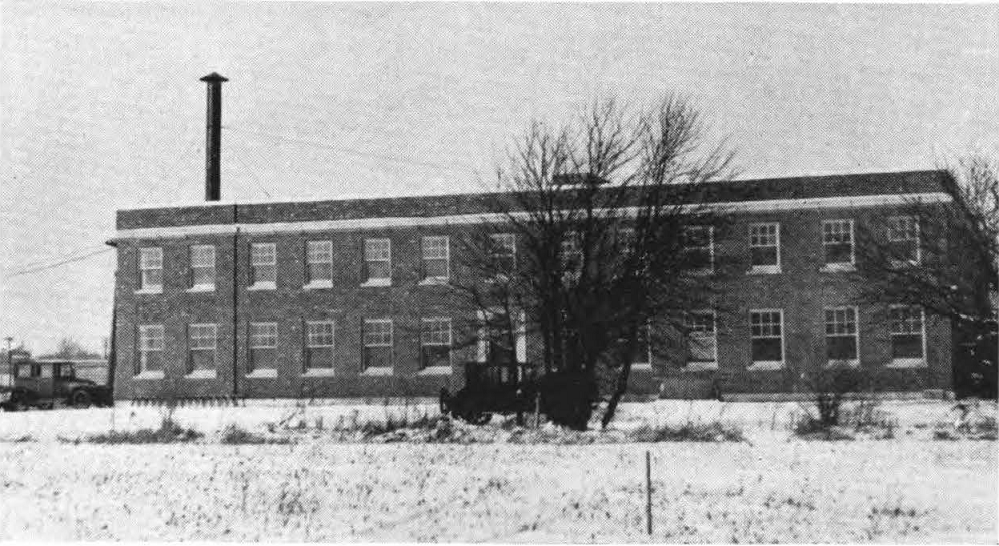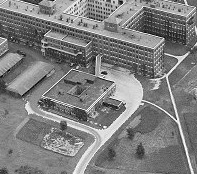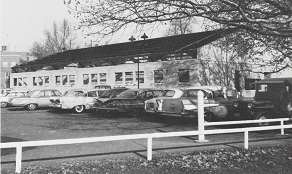
Period of the School and Hospitals 1921-1925. by George H. Whipple, M.D , page 9. (1957)
| Medical Center | Animal House |
 |
| Research Laboratory (Animal House), December, 1922 from Planning
and Construction Period of the School and Hospitals 1921-1925. by George H. Whipple, M.D , page 9. (1957) |
 |
 |
| 1935 Animal House adjacent to Strong Hospital from Rochester
Public Library |
Second Animal House (1963) |
The first building built on the new Medical Campus was a Research Laboratory that opened shortly after Thanksgiving in November 1922. Whipple's research assistant, Frieda Robscheit-Robbins, arrived in December accompanied by 40 dogs bought from San Francisco, which were carried in a special Railway Express car. This building, later known as the Animal House, provided office space and a small library while the main building was under construction
A second animal house was built adjacent to the first structure and opened in January 1963.
Both buildings were demolished in 1965 to allow construction of the new GG Wing.
References
1922 "Medical
College Beginning to Take Form," Rochester Review, 1(1):2
(October 1922)
The new building is the Research Laboratory, which was completed shortly
before we went to press, heat having been turned on November 6. The
building is scheduled for actual occupancy on November 15.
1927 Methods
and Problems of Medical Education, Series Seven, Division of
Medical Education of the Rockefeller Foundation, February 17, 1927.
Pages 15-19: Animal House, by George Hoyt Whipple
1936 The
First Decade 1926-1936
Page 18: Plans were drawn first of all for the two-story Research
Laboratory (now known as the Animal House), which was to be built as
quickly as possible so that it might serve during the construction of the
main building as temporary offices and laboratories. Ground for the
building was broken in August, 1922, and the building was occupied in
November. It provided temporary quarters not only for Dr. Whipple and Dr.
Bloor (representing pathology and biochemistry) but also for the
first-arriving members of the departments of anatomy, bacteriology,
medicine, obstetrics and gynecology, physiology, surgery, and vital
economics.
Here Dr. Faxon opened the first administrative offices of Strong Memorial
Hospital, with Dr. Thomas A. Devan, Assistant Director, and with his
Secretary, Miss Dorothy 0. Widner. The Medical Library also had its first
quarters in the building, as did the staff of the School of Nursing, the
Dietitian and the Purchasing Department.
The Research Laboratory, as it was called, was not only a temporary home,
but a testing place for all items of construction and equipment, and
housed a curious assortment of hardware, plumbing fixtures, and furniture,
from which the best was selected for the main building.
The building was ultimately to be used solely for the housing of animals.
As they arrived, they too were cared for in this building. It is
interesting to note that over a ten-year period the following kinds of
animals have been housed there from time to time: alligators, bears,
calves, cats, chickens, chipmunks, dogs, donkey, ferrets, frogs, geese,
goats, gophers, guinea pigs, horse, kangaroo, lizards, mice, monkeys,
mule, opossum, owls, pigeons, pigs, rabbits, rats, seal, sheep, skunk,
snakes, sparrows, squirrels, starlings, turtles and woodchucks.
1950 The
First Quarter Century 1925-1950
Page 133-134: Animal House, by Freida S. Robscheit-Robbins
The present Animal House started officially as a two-story Research
Laboratory and was the first building to be constructed in the School of
Medicine and Dentistry. The four corner areas served as temporary offices
and laboratories for Dr. Whipple, Dr. Faxon, Dr. Bloor, and Dr. Robbins.
One side of the upper floor housed the fast-growing Medical Library.
Within a short time the heads of the School of Nursing and the Department
of Dietetics occupied additional space on the second floor.
The entire building became a testing ground for different kinds of
furniture and laboratory equipment. No two faucets were alike, various
types of sinks were installed, tables were constructed of different
heights, and a variety of doors were used. Thus decisions were reached
concerning the type of equipment to be ordered or constructed for the main
building.
Some of the rooms on the lower floor were equipped with cages for dogs and
in December, 1922, these were filled with the anemia colony brought from
California for the investigations of Drs. Whipple and Robbins. This colony
consisted of twenty-three adult dogs and fourteen puppies of mixed white
bull terrier and Dalmatian stock. A few days later the first shipment of
monkeys arrived for the work of Dr. Corner.
All other available space in the Animal House was occupied for office or
laboratory purposes by the newly arriving members of the Medical School
and Hospital staff. By the time livable space became available in the main
Medical School Building, the Animal House or Research Laboratory was
filled to capacity. As construction was completed in the main building,
the Hospital staff and later the School faculty moved over. The "Research
Laboratory" then truly became an "Animal House."
1957 Planning
and Construction Period of the School and Hospitals 1921-1925.
bu George H. Whipple, M.D.| pdf |
Page 9: It was decided to construct a small building on the School
and Hospital tract-a relatively simple, two-story structure-to house the
growing staff over two or three years while the main building was
constructed, equipped and finally occupied. This building was called the
Research Laboratory and later became the Animal House. It was built
between August and November to supply rooms which were occupied late in
November, 1922. It gave ample space for Dr. Faxon, myself and other
members of the Hospital staff and School faculty to work on their plans
for their departments.
1962 "New Animal House,"
University Record 2(11):6 (December, 1962)
Construction started in mid-October on a one-story structure to house
animals used in medical teaching and research. The new facility will
provide urgently needed animal space for teaching and research programs to
supplement the present animal house which was built in 1926. The new
construction is adjacent to the existing animal building and will be used
principally to house larger animals. Completion date is estimated to be
January 1, 1963.
1965 "UR's Old Animal House Reduced to Rubble Pile," Democrat and Chronicle, February 13, 1965, Page 3B.
1975 To
each his farthest star: The University of Rochester Medical
Center -1925-1975, edited by Edward C. Atwater and John
Romano.
Page 252: The old animal house, the first building constructed at
the Medical Center, was torn down in 1965 to make room for the extension
northward of G Wing (GG Wing) to house research and animal-care
facilities.
© 2021 Morris A. Pierce